Dramatic, Durable Interiors Using Sintered Stone
Creating Sintered Stone
The manufacturing process is essentially the same for most sintered stone products, regardless of their final use. We will review this process briefly as follows.
Raw Material Extraction
Sintered stone requires a combination of different materials mined from different locations, all selected based on their ability to provide various desired characteristics. Sand materials such as silica, quartz, and feldspars are used to provide hardness, strength, and chemical stability. Clay may be used to provide elastic properties useful during manufacturing and finishing. Natural mineral pigments of different types can be used to create different colors or chromatic properties in the final product. Some of these are similar to materials that are used for ceramic and porcelain ceramic products. However, the raw materials for sintered stone are selected and processed to be finer and more pure than those used in tile in order to guarantee a more uniform end product. Once all of these ingredients are located and mined, they are processed in an atomizer where they are ground and treated before being transported to the manufacturing facility to be stored until ready for processing. Since these are all natural materials, they can contribute to a green and sustainable design in the context of practicing environmentally responsible mining practices.
Manufacturing Process
With the raw materials ready at the manufacturing plant, a mechanized process needs to be employed to create sintered stone. The machinery used to process the raw materials is unique and designed specifically for sintering with state-of-the-art technology to ensure a high-quality product. The first step is to prepare the compact from the raw materials into a spray-dried mixture of sands, clays, and pigment. This mixture, along with a specific but limited amount of water, is then pressed to form an unfired slab ready to be decorated or colored to suit specific appearance or design requirements. The pressing process can require on the order of 6,000 to 15,000 pounds per square inch (psi) to properly densify the slab, which is significantly higher than the weight used for ceramic material pressing.
Once a pressed compact is ready, it can be fired in a large kiln at temperatures below the melting point of the minerals at normal atmospheric pressure. The pressed material is fired for almost 2 hours, substantially longer that traditional ceramics, which have firing cycles of around 40 minutes. These longer firing cycles create a product with a stronger, nonabsorbent surface. During this process, the hardening or vitrification occurs, which may create some limited shrinkage in the slab. This is also the point, however, where the sintering takes place, allowing the material to densify and become nonporous. Note that there is no extrusion involved as is common in other materials. Instead, the pressing plus the heat in a kiln produce strong, thin sheets in thicknesses on the order of 1/8 inch, 1/4 inch, 1/2 inch, or 3/4 inch when finished. All of these enhancements in both raw materials and production techniques result in a product with superior technical characteristics compared to ceramic products.
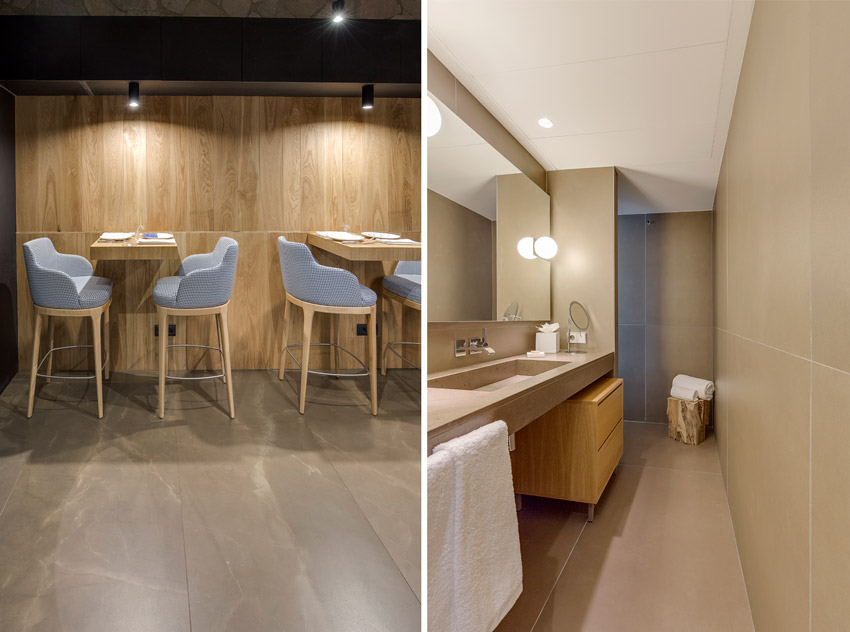
Sintered stone panels are manufactured in large-format sizes that help minimize joint/grout lines, speed installation, and save on cost.
The finished, manufactured products can be produced based on the capabilities of the manufacturing equipment. The thickness plus the overall face size of the sheets, or panels, can vary by manufacturer, particularly since many provide metric sizes due to their location in countries that rely on metric measurements. At least one manufacturer, however, offers non-metric sizes in 4-foot-by-12-foot and 5-foot-by-10-foot panels to match American construction sizes.
Fabrication
With the panels fully formed, they next need to be fabricated for use as a building material. The so-called “raw slab” comes out of the kiln with rough edges so the slab needs to be squared and rectified before it is ready for installation. Once that is done, the panels can be cut to specific sizes either at the plant or in the field in a number of ways. The most common is to use specific tools to score one side of the sintered stone and then bend or “snap” along the score to separate the two pieces. For cutting holes or shapes, wet diamond saws or high-pressure water jet machinery can be used, all suitable for dense stone materials and providing a high degree of precision. In cases where the material is being applied to a corner, a mitered edge can be fabricated by cutting the slab at 45 degrees and 135 degrees using a bridge saw or waterjet. Then, the two pieces can be adhered together creating a full mitered edge.
It should be noted that handling the thin panels is not much different than handling glass panels, although the sintered products are stronger. Nonetheless, even with the high flexural strength found in sintered stone, handling should always be done using appropriate handling equipment. That includes frames with mechanical suction cups to support and move the panels safely just like moving glass or stone panels.
Sintered Stone in Interior Design
With an understanding of the design and performance characteristics of sintered stone, it is easy to see why it is finding its way into more interior designs. Common interior installations include new or renovated walls, floors, and other surfaces where high design and high durability are paramount. In this regard, sintered stone is being used in very creative ways to express the architectural intentions of notable architects around the world. For instance, RCR Arquitectes from Spain used it in a dramatic fashion in a recent project for the ENIGMA restaurant in Barcelona. To achieve the intended look, it used a self-produced watercolor as a basis for a manufacturer to create a custom-colored sintered stone that was used extensively on floors, walls, counters, and furniture. As designers of a large body of expressive and important work over the past 30 years, RCR has received international acclaim, including the firm principals Rafael Aranda, Carme Pigem, and Ramon Vilalta being named the recipients of the 2017 Pritzker Prize for Architecture.
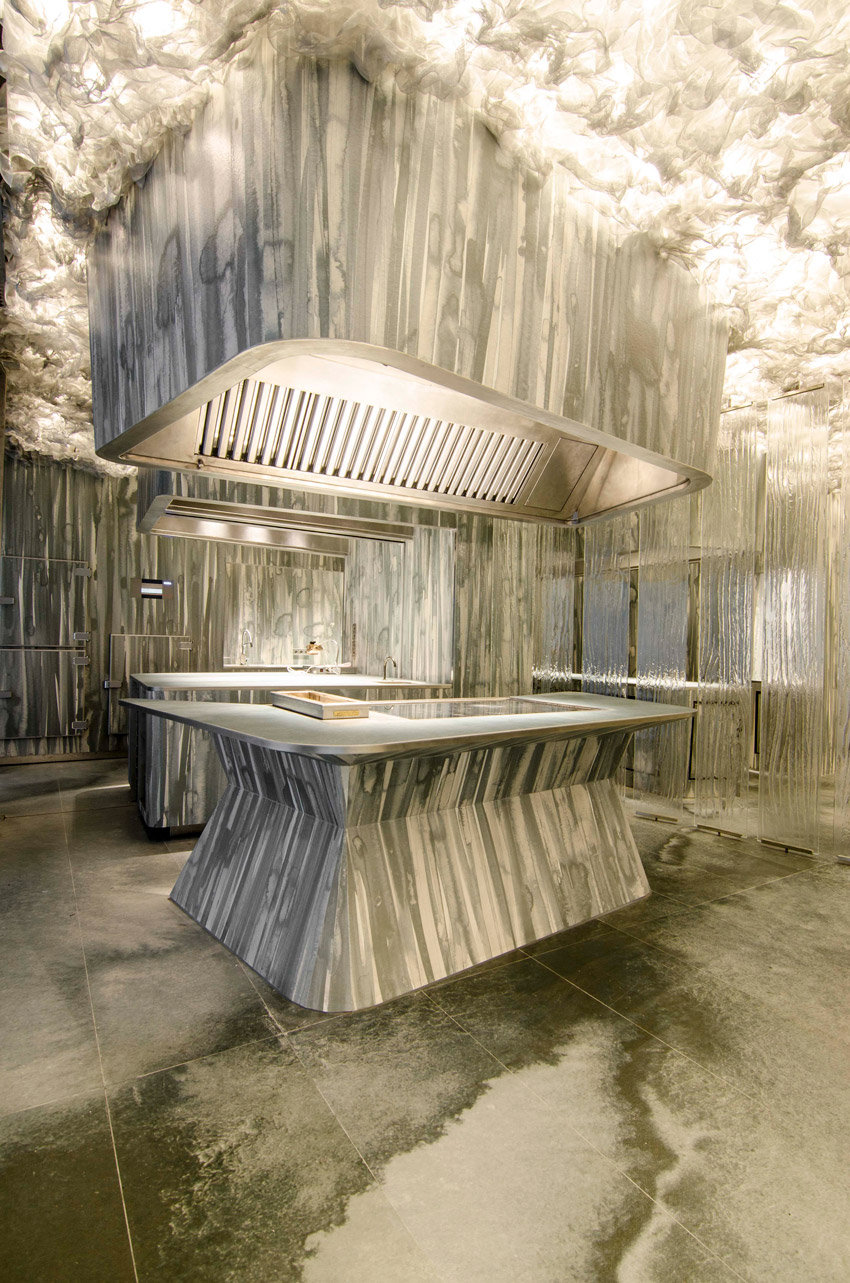
2017 Pritzker Prize winners at RCR Arquitectes used custom-colored sintered stone throughout the ENIGMA Restaurant in Barcelona.
Beyond the extensive design capabilities, there are some notable performance advantages in interior installations, the first of which is the large size format (up to 4 feet by 12 feet or 5 feet by 10 feet). Using panels of this size necessarily reduces the number of joints and grout lines along a surface, which provides a much cleaner, uniform aesthetic. It also contributes to an improved hygienic factor for the space since it is the grout that commonly harbors dirt or other contaminants. The large size panels also reduce installation time compared to using smaller tiles that need to be set and installed individually.
The characteristics of sintered stone as a product make it attractive for installation as well. It’s very light size-to-weight ratio means that it can be readily installed on standard light-gauge metal framing wall systems without requiring any extra stiffening or reinforcing. The fact that it is a thin product (down to 1/8 inch) means that sintered stone can often be installed directly over existing surfaces in renovation projects. That not only avoids demolition and waste disposal of existing surface materials, but it can also mean that existing trim and other features can be preserved and reused without the need to be adjusted to accommodate thicker materials. For most other applications, the most widely used thickness in the United States is 1/4 inch, providing strength in a relatively lightweight product that is cost effective and durable.
Floor Surfaces
When used specifically for floor surfaces, sintered stone is suitable for all types of spaces, from large hotel lobbies to midsize retail or restaurant settings to small bathrooms, and just about everything in between. The degree of wear resistance needed in any of these spaces can be accommodated by picking the proper thickness of sintered stone to suit the situation. The choices of thickness can also help provide smooth transitions with adjacent floor finishes.
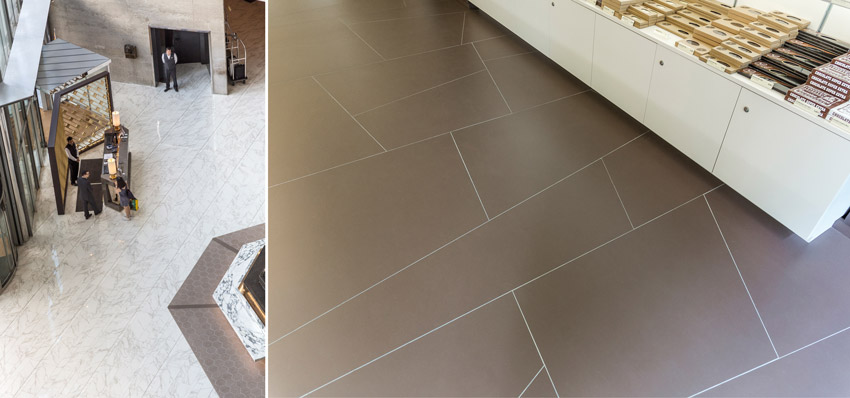
Sintered stone flooring can create dramatic visual effects, including custom shapes, while remaining durable and easy to maintain.
Sintered stone flooring is best installed using common thinset adhesion and grouting techniques similar to ceramic tile installation. The underlying subfloor or substrate needs to be cleaned, and if waterproofing is required, that should be installed first. In some cases, some self-leveling materials may be required, particularly in existing buildings. Then an appropriate thinset adhesive can be applied to the substrate and made ready to receive the sintered stone in common fashion. In the interest of achieving a level surface and even spacing of the panels, common floor tile installation tools and accessories can be used. For large areas, control or expansion joints need to be coordinated with the rest of the building structure and can be filled with an elastomeric sealant. Once the sintered stone panels are in place and set, then the panel joints can be grouted and finished.
One of the common criteria for floors in public spaces is the tested slip resistance of the flooring material. Up until the year 2014, the standard test was based on a static coefficient of friction (SCOF) following specific testing procedures developed by ASTM International. Since then, the new test standard has been based on a dynamic coefficient of friction (DCOF), which tests for slip resistance based on an object being already in motion—in other words, more closely aligned with a person walking along the floor. The industry standard for achieving appropriate slip resistance in flooring is a tested 0.42 DCOF. Since sintered stone products can be produced with different surface types, they can produce different DCOF ratings. Many, however, have been tested and shown to meet or exceed this test standard, making them very suitable for all types of flooring applications, particularly for high-traffic areas, such as lobbies and hallways, and wet areas, such as bathrooms and kitchens.
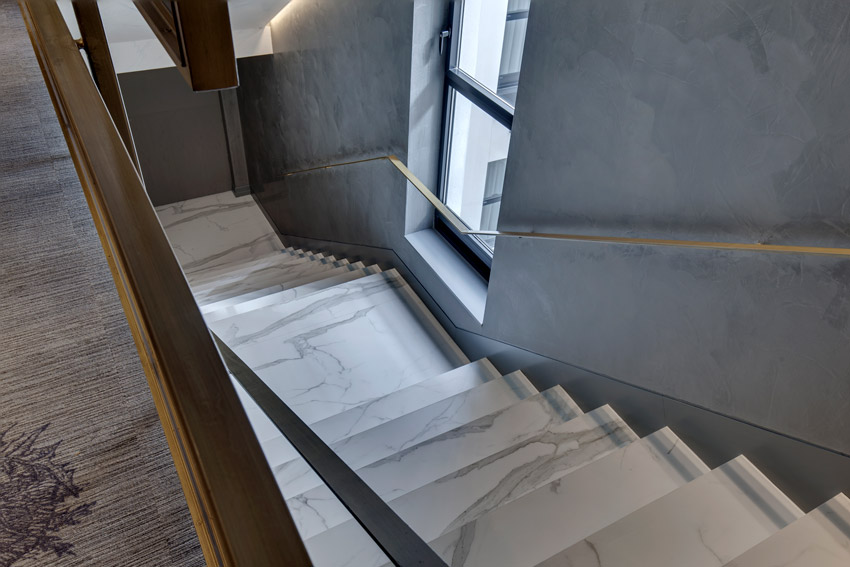
Using sintered stone on stairs is a logical extension of using it on floors and walls in a building.
Interior stairs are another area where sintered stone has been used successfully, particularly where appearance, durability, and slip resistance are key criteria. In these situations, the sintered stone can be cut to cover the treads and the risers and even integrate with adjacent walls, balusters, etc. Standard safety nosings can be incorporated as may be needed, or the material can be used to fully cover the stairs.
As noted already, sintered stone can be created to take on the very accurate appearance of marble, granite, other stone, wood grain, tile, and more depending on the manufacturer. For flooring, this means that designers have a full palate of colors and textures from which to choose. Grand spaces can have sintered stone floors that look like marble, granite, or other dramatic stone, including the capability to create patterns and stone imagery that is more readily controlled than stone materials. For restaurant and retail spaces, the colors and textures can be selected to complement the rest of the decor and create spaces that are bold and strong or soft and intimate depending on the situation. For bathroom and kitchen spaces, surfaces that look like marble or create contrasts of colors, including the creation of tubs and other items, can be designed to meet the intended results.
Wall Surfaces
In addition to floors, walls provide particularly intriguing design possibilities using sintered stone. The large-format panels can cover large areas with the full range of colors, patterns, and textures to create spaces that have strong, durable wall finishes. As such, it is suitable for all vertical wall surfaces and any incidental horizontal surfaces, such as shelves, offsets, or recesses. Since it is easy to clean and very dense, its hygienic properties make it appropriate not only for public spaces but also for private spaces, such as guest room bathrooms, kitchens, etc. In fact, it has also been used to create countertops since it can be certified for food preparation areas.
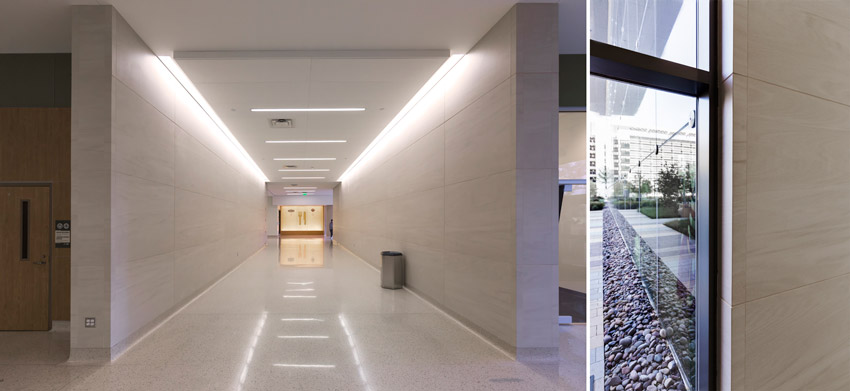
Elegant wall surfaces can be created and detailed with sintered stone panels, as in the Parkland Hospital Dallas shown here.
Installation on walls is fairly straightforward due to the thin, lightweight properties of sintered stone panels. Similar to floors, the wall substrate needs to be prepared and readied but does not typically require anything unusual. Standard coordination with wall framing and use of an appropriate backing board, such as would be used for tiled surfaces, are the best places to start. Then the use of thinset adhesive in a manner similar to floors can be employed for wall surfaces up to 10 feet in height. For any panels installed above 10 feet above the floor, the recommended procedure is to use wall clips recessed onto the back of the sintered stone panels that are secured to the wall as part of the thinset application. Once all of the sintered stone panels are in place with the appropriate spaces between them, grout can be applied and the panels cleaned to be ready for use.
Particularly relevant to wall finishes, sintered stone panels are available in gloss, satin, or rough finishes to emulate the full range of material appearances noted previously. That means the walls can coordinate directly with flooring choices if desired or be selected to be intentionally different to create a wide range of interior finish designs. Of particular note is the design possibility of using striking book-match or end-match effects of panels that have veined designs, such as would be found in marble or other stones. The challenge with using natural stone for those purposes is the randomness of the veining and the difficulty in obtaining true matching panels to install. Since the sintered stone panels are manufactured, however, the veining and patterns can be very precisely controlled to achieve very dramatic and artistic looks.
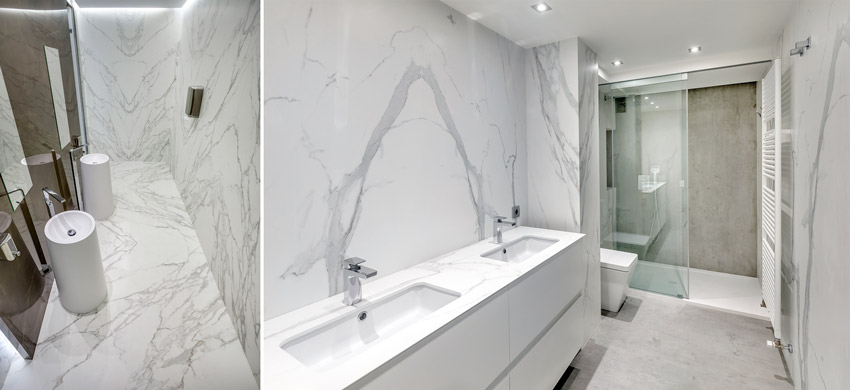
Book-match and end-match patterns are readily achievable with striking results using sintered stone panels that emulate marble and other stone.









